Georges Emile Barbier (24-02-1844 - 16-12-1895) French composer
Barbier became famous for the 1895 endgame study which was initially published as a draw study, until Rev. Saavedra found the winning promotion.
Saavedra, Fernando & Barbier, Georges Emile
Glasgow Weekly Citizen, 1895
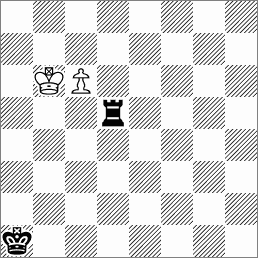
Show Solution1. c7 Rd6+ 2. Kb5 Rd5+ 3. Kb4 Rd4+ 4. Kb3 Rd3+ 5. Kc2 Rd4! 6. c8=R!
{Barbier's solution continued with 6. c8=Q Rc4+ 7. Qxc4 stalemate}
6... Ra4 7. Kb3 and wins.
For a quick look at the history of this endgame, you may look at the
Wikipedia webpage. For further details and a reproduction of Barbier's column in the Weekly Citizen, browse
Tim Krabbé's website.
Consider solving the problem below, for the fun of it:
Barbier, Georges Emile
Brooklyn Standard Union 27/01/1894
White retracts one moves and mates in one.
Show Solution-1.f7xSg8=R & 1.f8=S#
Ralph Herbert Bridgewater (24-02-1874 - 12-1948) British composer
Bridgewater obtained a few prizes for some mutate twomovers, but we have not selected a mutate:
Bridgewater, Ralph Herbert
Daily News, 1926
Prize
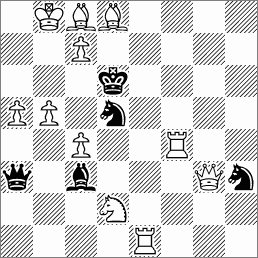
Show SolutionSet play:
1...Qc5 2.Rf6#/Re6#
1...Be5 2.Se4#
1...Se7/Sdxf4/Sf6/Sxc7/Sb4/Sb6 2.Bxe7#
1.Re5! (2.Rxd5#)
1...Kxe5 2.Re4#
1...Kc5 2.Be7#
1...Qc5 2.Re6#
1...Bxe5 2.Se4#
1...Se3/Se7/Sf6/Sb4/Sb6 2.Rf6#
1...Sxc7 2.Bxc7#
One changed mate and one transferred mate compensate for the lack of mate in set play on the flight 1...Kc5.
Liss Olof Karlsson was a multivalent composer. You may pick any of this miniature
twomover with Y-flight of the black King, of this
helpmate in 3 with Allumwandlung, of this grotesque
selfmate. The study below has a clear solution:
Karlsson, Liss Olof
Tidskrift för Schack, 1946 (67)
2
nd Prize

Show Solution1. e6 Sxe6
{1... Rxd6 2. e7 Ke5+ 3. Ke3}
2. Sxe6+ Ke5 3. c7
{3. Sxd8 Kxd6 }
3... Rxd6+ 4. Sd4! Rxd4+ 5. Kc3 Rd1 6. Kc2 wins.
Refusal of capture followed by an active sacrifice (4.Sd4): a classical study.
Zoltán Zilahi (24-02-1903 - 10-05-1971) Hungarian composer
Zilahi left a
theme bearing his name: in each of two phases, the mating unit of one phase is captured in the other phase. The typical example is
this problem.
The Zilahi theme has been thoroughly exploited in the helpmate genre ever since, but Zilahi composed many successful twomovers, such as this one:
Zilahi, Zoltán
Gavrilov MT, 1948
1
st Prize
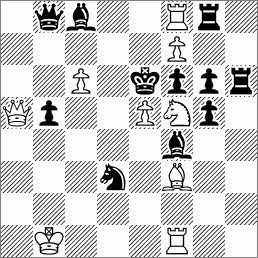
Show Solution1.Qd8! (2.Qxf6#)
1...Sxe5 2.Sd4#
1...fxe5 2.fxg8Q#/fxg8B#
1...Qxe5 2.Qxc8#
1...Bxe5 2.Bd5#
1...Kxe5 2.Qd5#
1...gxf5 2.Qe8#
Black defends by playing with four pieces on the same square; White mates by replying with a piece of the same type. In the 5th variation, the black King plays on this same square. This problem was reproduced in the FIDE-Album.
Aleksander Goldstein (24-02-1911 - 28-09-1988) Polish composer
Aleksander Goldstein composed in many genres with elegance. A typical example in three moves:
Goldstein, Aleksander
«64» 1940
3
rd Prize
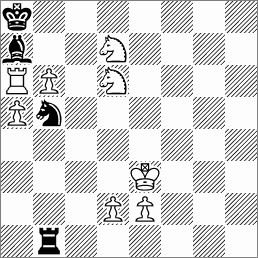
Show Solution
1.Kf2 ! ZZ
1...Rb4 2.d4! (3.b7#) 2...Sb5~ 3.Rxa7#
1...Rb3 2.e3! (3.b7#) 2...Sb5~ 3.Rxa7#
1...Rb2 2.Kg2! (3.b7#) 2...Sb5~ 3.Rxa7#
1...Rb1~ 2.Rxa7+ Sxa7 3.b7#
The white pawns 'd' and 'e' unpin white pawn 'b'.
Henry Olof Axel Forsberg was with the Forsberg twins. Rudolf also composed special problems such as this threemover:
Forsberg, Rudolf
Cheylan-50 JT, 1989
HM
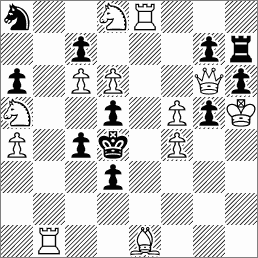
Show Solution
1.Bd2 ! ZZ
1...g4 2.Re5 (3.Se6# A) 2...Kc5 3.Be3# B
1...Sb6 2.Rc1 (3.Be3# B) 2...Kc5 3.Sb3# C
1...cxd6 2.Rb4 (3.Sb3# C) 2...Kc5 3.Se6# A
1...Kc5 2.Be3+/Se6+Bc3 ABC
(1...Rh8 2.Qxg7+ Kc5 3.Sb7#)
Ukrainian theme (
Cyclic Le Grand) in #3
(Yuri A. Pavlov)
Павлов, Юрий А.
Ukraine
1
st Place
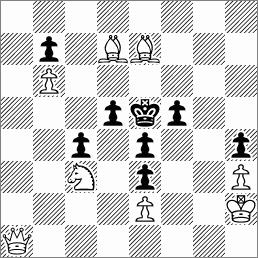
Show SolutionSet play: 1...Kf4[a] 2.Sxd5#[A] 1...Kd4[b] 2.Sb5#[B]
1.Qa3? ZZ 1...Kf4[a]/d4[d] 2.Qd6#[C] 1...Kd4[b] 2.Bf6#[D] but 1...f4[c]!
1.Qg1? ZZ 1...Kf4[a] 2.Bd6#[E] 1...Kd4[b]/f4[c] 2.Qg7#[F] but 1...d4[d]!
1.Qa8! ZZ 1...Kf4[a]/d4[d] 2.Qb8#[G] 1...Kd4[b]/f4[c] 2.Qh8#[H]
Zagoruiko 4x2.
Visintin, Augusto
Sinfonie Scacchistiche, 1965
3
rd Prize, 1965-1967

Show Solution1.Kb5 Bd2 2.Be3 Bd3#
1.Ka5 Bd3 2.Be4 Bd2#
Umnov, unpinning, interchange of functions between the two white Bishops, chameleon echo mates.
(Eduard Frantsevich Kudelich)
Eduard Kudelich is an endgame study composer.
Куделич, Эдуард Францевич
Шахматная поэзия 2001 (1096)
2
nd Honorable Mention
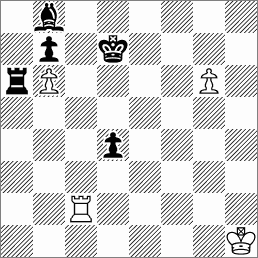
Show Solution
1. g7 Ra1+ 2. Kg2 Bh2 3. Rc8
{3. Kxh2 Ra8 4. Rc7+ Kd6 5. Rf7 Rg8 6. Kg3 Kc6 7. Kf4 Kxb6 8. Kg5 d3 9. Kg6 Rd8 10. Rf6+ Kc5 11. Rf5+ Kb4 12. Rf4+ Kc3 13. Rf8 Rd6+ 14. Rf6 Rxf6+}
3... Rg1+ 4. Kxh2 Rxg7 5. Rc7+ wins the Rook.
Александр Николаевич Мельничук (24-02-1958) Russian composer (Aleksandr Nikolaevich Melnichuk)
Aleksandr Melnichuk has composed mostly direct mates (#3 and #4).
Мельничук, Александр Николаевич
Кудесник 2006 (99/3061)
1
st Prize, 8
th TT

Show Solution
1.Rb7 ! ZZ
1...Kd6 2.Ke4 (3.Rc2 ~ 4.Rc6#)
1...Kf5 2.Rb6 ZZ Ke5 3.Kg4 ~ 4.Re6# or 2...Kg5 3.Rh2 Kf5 4.Rh5#
1...Kf6 2.Kxf4 ZZ Kg6 3.Rh2 ZZ Kf6 4.Rh6#
Zoran Gavrilovski is the editor of the "Macedonian Problemist". Some recent originals published in the
MP can be found on
this Italian problemists website. He is also the
Synthetics sub-editor of "The Problemist".
Zoran Gavrilovski composes direct mates or helpmates with the same great talent.
Gavrilovski, Zoran S.
Variantim, 1994
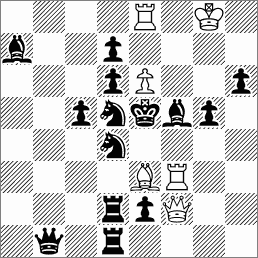
Show Solution1.Sxe6 Bxc5 2.Bd3 Qd4#
1.Bxe6+ Rf7 2.Sc2 Qf5#
Bristol, self-pinning, self interference.

Werner Schmoll (right) with Camillo Gamnitzer (left) and Alois Nichtawitz (center)
harmonie 132 - 2016
|
Alois Nichtawitz composes direct mates. His self-portrait in German can be found
on this Austrian problem site as well as
15 of his problems.
Nichtawitz, Alois
Schach-Aktiv (/3792) 2011-04

Show Solution1. Bxc6!
1... bxc6 2. e8=R ZZ 2... Kd7 3. Rd8#
1... bxa6 2. e8=B ZZ 2... Ke5 3. Qxc7#
1... b6 2. e8=Q bxa5/b5 3. Qe6#
1... b5 2. e8=S+ Kxc6/e5 3. Qxc7#
Secondary variation: 1... Kxc6 2. e8=Q+ Kd6 3. Qe6#
Pickaninny combined with
Allumwandlung in a very economical form.
David Blundell (24-02-1962) Welsh composer

David Blundell
[Source: ARVES]
|
David Blundell teaches match and composes endgame studies. His studies are rather analytical and hard to solve.
More about him can be read on
his ARVES webpage.
Blundell, David
1
st Prize, The Problemist 2012

Show SolutionTry:
1.♔a1? fails because of 1...♔b3 2.♔b1 a6 3.♔a1 a5 4.♔b1 a4 5.♔a1 a3 6.♔b1 a2+ 7.♔a1 ♘g4 8.h7 ♘e3 9.h8=♕ ♘c2#
1.♔c2! succeeds because after 1...a5 2.♔c3 a4 3.♔c2 ♔b4 4.♔b2 a3+ 5.♔b1! ♔b3 6.♔a1= White has reached the same position as in the try but with the black Pawn on a3 instead of a2.
The other variation makes the study all the richer and all the more difficult for the solver:
1...a6 2.♔d3 ♔b3 3.♔d2 ♔b2 4.♔e3 going for the attack on the black Knight now that the black King stands on the a1-h8 diagonal 4...a5 5.♔f4 a4 6.♔f5 a3 7.♔×f6 a2 8.h7 a1=♕ 9.♔g7=

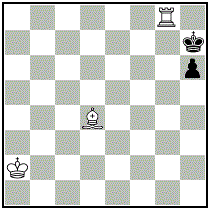







No comments:
Post a Comment